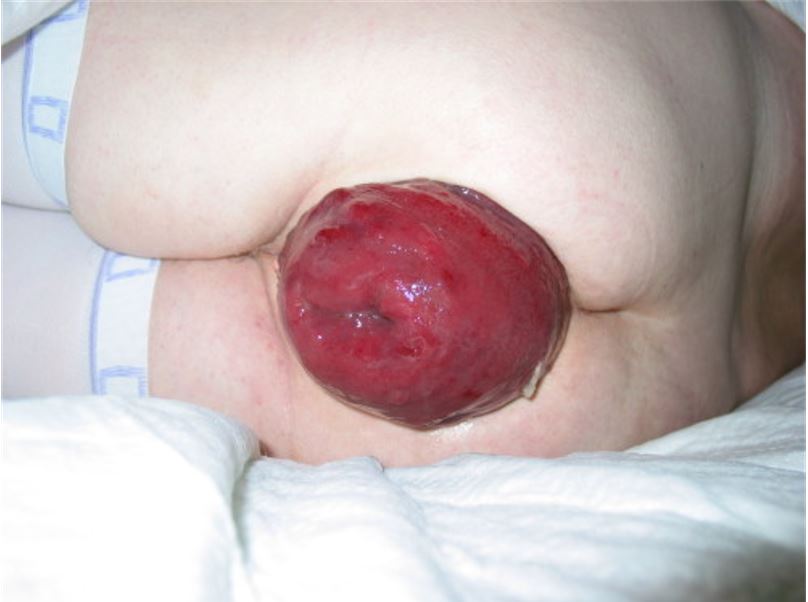Playlist
Show Playlist
Hide Playlist
Rectal Prolapse
-
Slides GIP Rectal Prolapse.pdf
-
Download Lecture Overview
00:01 Welcome. With this talk, we're going to cover another aspect of recto anal pathology in this case, rectal prolapse. 00:12 So, rectal prolapse is just as the name says, a protrusion of the rectal tissue, musculature and bowel wall through the anus into the outside world. 00:23 The epidemiology of this overall, so, there is a bimodal incidence. 00:27 There are older adults with laxity of the bowel floor and typically, in women who've had multiple childbirths as we'll see in a minute. 00:38 But also, children and this is more of a developmental defect in the floor of the pelvis. 00:44 And so, they tend to manifest earlier. The distribution by sex. 00:48 So, because this is so intensely associated with pregnancy and recurrent pregnancies, the incidence of rectal prolapse is much more common in women than in men but girls and boys are the same. 01:01 So, the developmental defect that's happened before the ages of five with that manifestation are going to be equally divided amongst said genders. 01:10 The risk factors are essentially, an intraabdominal increase in pressure or bowel motility issues, straining, straining at delivery. 01:19 Diarrhea, constipation, vaginal delivery, multiparity, having more than one child, and overall, pelvic floor dysfunction for a variety of reasons, including some that are neurogenic. 01:31 So, these all make infinitely good sense. Kind of two varieties and this is all on a spectrum. 01:38 It's not two separate diseases. 01:40 You may have a partial thickness prolapse which is just a submucosa and the mucosa. 01:46 So, a relatively modest amount of tissue that is prolapsing. 01:51 And then, you may have complete full thickness prolapse where the weakness at the anus and in the pelvis muscles allow whole segments of the bowel to prolapse. 02:02 So, it's full thickness, mucosa, submucosa, and muscularis that are prolapsed into the outside world. 02:10 I'm going to show you a picture in a moment. Just a trigger warning, this is not pretty, not pretty. 02:17 So, this is a full thickness, complete rectal prolapse You can say, yeah, with that part of the rectum protruding out, I can understand why the patient may be straining at stool, why they may be constipated, why there may be incontinence, all of those things. 02:33 The urinary continence is because of associated pressure and/or inflammation on the bladder and urinary bladder and urethra. So, there may be some degree of urinary incontinence but also, some partial prolapse of that musculature, too, is going to be involved in the urinary incontinence. 02:51 Because in the same general vicinity, there will be a uterus and you may have uterine prolapse through the same laxity of the floor of the pelvis. 03:04 And clearly, rectal bleeding. Making the diagnosis, in general, it's not hard. 03:11 So, it's going to be clinical and you're going to see outpouchings of various parts of the bowel, of the rectum and anus and that's how you're going to make your diagnosis. 03:21 You want to make sure that it's truly rectum, normal rectum and not a mass - a perianal mass or tumor. 03:29 But beyond that, you'll kind of look at it and go, hmm, that's rectal prolapse. You can do defecography. 03:38 So, this is basically MRI that's going to be looking with some other imaging such as barium or something else to see exactly what kind of prolapse that's going to be involved or important for surgical management. 03:53 Pelvic physiologic studies, I mean, we're going to make sure the muscles work and see what kind of defect there may be there and colonoscopy, largely probably not done but it can allow you to do biopsies in the case where you think that this is being driven by, say, inflammatory bowel disease. 04:13 Management, so, we want to minimize the pressures that are going to maybe expand or increase the rectal prolapse. 04:23 So, we want to make sure that there is good fiber intake, softer stools, good fluid, avoid straining at stool. 04:29 So, all of those things that you see in, like, the top three. You can actually improve the musculature. 04:36 You can basically pump iron for the pelvis and there's certain pelvic floor exercises that can be done and are recommended for women who've had multiple pregnancies. 04:46 Managing predisposing conditions such as inflammatory bowel disease, etc. 04:53 And then, in a significant number of these cases, it's going to require a surgical intervention to pull the rectum back up, to increase the strength of the musculature in that area, usually, by tightening around the anus. 05:14 And so, surgical management is going to be a mainstay. With that, we've covered rectal prolapse.
About the Lecture
The lecture Rectal Prolapse by Richard Mitchell, MD, PhD is from the course Small and Large Intestines Disorders.
Included Quiz Questions
Which of the following statements about rectal prolapse is true?
- It has a bimodal incidence.
- It is most common among patients 20–30 years old.
- It is more common in men.
- Decreased intra-abdominal pressure is a risk factor.
- C-section is a risk factor.
What is necessary for the diagnosis of rectal prolapse?
- Clinical examination
- MRI
- CBC
- Defecography
- Pelvic physiology studies
What is part of the management of rectal prolapse? Select all that apply.
- Adequate fiber and fluid intake
- Stool softeners
- Straining avoidance
- Laxatives
- Colectomy
Customer reviews
5,0 of 5 stars
| 5 Stars |
|
5 |
| 4 Stars |
|
0 |
| 3 Stars |
|
0 |
| 2 Stars |
|
0 |
| 1 Star |
|
0 |




